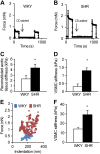Increased vascular smooth muscle cell stiffness: a novel mechanism for aortic stiffness in hypertension
- PMID: 23709594
- PMCID: PMC3840243
- DOI: 10.1152/ajpheart.00232.2013
Increased vascular smooth muscle cell stiffness: a novel mechanism for aortic stiffness in hypertension
Abstract
Increased vascular stiffness is fundamental to hypertension, and its complications, including atherosclerosis, suggest that therapy should also be directed at vascular stiffness, rather than just the regulation of peripheral vascular resistance. It is currently held that the underlying mechanisms of vascular stiffness in hypertension only involve the extracellular matrix and endothelium. We hypothesized that increased large-artery stiffness in hypertension is partly due to intrinsic mechanical properties of vascular smooth muscle cells. After confirming increased arterial pressure and aortic stiffness in spontaneously hypertensive rats, we found increased elastic stiffness of aortic smooth muscle cells of spontaneously hypertensive rats compared with Wistar-Kyoto normotensive controls using both an engineered aortic tissue model and atomic force microscopy nanoindentation. Additionally, we observed different temporal oscillations in the stiffness of vascular smooth muscle cells derived from hypertensive and control rats, suggesting that a dynamic component to cellular elastic stiffness is altered in hypertension. Treatment with inhibitors of vascular smooth muscle cell cytoskeletal proteins reduced vascular smooth muscle cell stiffness from hypertensive and control rats, suggesting their participation in the mechanism. This is the first study demonstrating that stiffness of individual vascular smooth muscle cells mediates vascular stiffness in hypertension, a novel concept, which may elucidate new therapies for hypertension and for vascular stiffness.
Keywords: atomic force microscopy; hypertension; pulse wave velocity; vascular smooth muscle; vascular stiffness.
Figures





Similar articles
-
Inhibition of SRF/myocardin reduces aortic stiffness by targeting vascular smooth muscle cell stiffening in hypertension.Cardiovasc Res. 2017 Feb;113(2):171-182. doi: 10.1093/cvr/cvw222. Epub 2016 Oct 23. Cardiovasc Res. 2017. PMID: 28003268 Free PMC article.
-
Augmented vascular smooth muscle cell stiffness and adhesion when hypertension is superimposed on aging.Hypertension. 2015 Feb;65(2):370-7. doi: 10.1161/HYPERTENSIONAHA.114.04456. Epub 2014 Dec 1. Hypertension. 2015. PMID: 25452471 Free PMC article.
-
Rho Kinase Regulates Aortic Vascular Smooth Muscle Cell Stiffness Via Actin/SRF/Myocardin in Hypertension.Cell Physiol Biochem. 2017;44(2):701-715. doi: 10.1159/000485284. Epub 2017 Nov 23. Cell Physiol Biochem. 2017. PMID: 29169155 Free PMC article.
-
Changes in arterial smooth muscle contractility, contractile proteins, and arterial wall structure in spontaneous hypertension.Proc Soc Exp Biol Med. 1994 Nov;207(2):148-74. doi: 10.3181/00379727-207-43802. Proc Soc Exp Biol Med. 1994. PMID: 7938046 Review.
-
Vascular smooth muscle contraction in hypertension.Cardiovasc Res. 2018 Mar 15;114(4):529-539. doi: 10.1093/cvr/cvy023. Cardiovasc Res. 2018. PMID: 29394331 Free PMC article. Review.
Cited by
-
Calcium/calmodulin-dependent kinase II inhibition in smooth muscle reduces angiotensin II-induced hypertension by controlling aortic remodeling and baroreceptor function.J Am Heart Assoc. 2015 Jun 15;4(6):e001949. doi: 10.1161/JAHA.115.001949. J Am Heart Assoc. 2015. PMID: 26077587 Free PMC article.
-
The Role of Vascular Smooth Muscle Cells in Arterial Remodeling: Focus on Calcification-Related Processes.Int J Mol Sci. 2019 Nov 14;20(22):5694. doi: 10.3390/ijms20225694. Int J Mol Sci. 2019. PMID: 31739395 Free PMC article. Review.
-
AFM-based nanoindentation indicates an impaired cortical stiffness in the AAV-PCSK9DY atherosclerosis mouse model.Pflugers Arch. 2022 Sep;474(9):993-1002. doi: 10.1007/s00424-022-02710-x. Epub 2022 Jun 1. Pflugers Arch. 2022. PMID: 35648220 Free PMC article.
-
Vasoactive agonists exert dynamic and coordinated effects on vascular smooth muscle cell elasticity, cytoskeletal remodelling and adhesion.J Physiol. 2014 Mar 15;592(6):1249-66. doi: 10.1113/jphysiol.2013.264929. Epub 2014 Jan 20. J Physiol. 2014. PMID: 24445320 Free PMC article.
-
Biomimetic soft fibrous hydrogels for contractile and pharmacologically responsive smooth muscle.Acta Biomater. 2018 Jul 1;74:121-130. doi: 10.1016/j.actbio.2018.05.015. Epub 2018 May 16. Acta Biomater. 2018. PMID: 29753912 Free PMC article.
References
-
- Arner A, Hellstrand P. Energy turnover and mechanical properties of resting and contracting aortas and portal veins from normotensive and spontaneously hypertensive rats. Circ Res 48: 539–548, 1981 - PubMed
-
- Arner A, Uvelius B. Force-velocity characteristics and active tension in relation to content and orientation of smooth muscle cells in aortas from normotensive and spontaneous hypertensive rats. Circ Res 50: 812–821, 1982 - PubMed
-
- Baguet JP, Kingwell BA, Dart AL, Shaw J, Ferrier KE, Jennings GL. Analysis of the regional pulse wave velocity by Doppler: methodology and reproducibility. J Hum Hypertens 17: 407–412, 2003 - PubMed
-
- Benetos A, Laurent S, Asmar RG, Lacolley P. Large artery stiffness in hypertension. J Hypertens Suppl 15: S89–S97, 1997 - PubMed
Publication types
MeSH terms
Substances
Grants and funding
- R01-HL-106511/HL/NHLBI NIH HHS/United States
- R01 HL119464/HL/NHLBI NIH HHS/United States
- P01-AG-027211/AG/NIA NIH HHS/United States
- R01 HL106511/HL/NHLBI NIH HHS/United States
- R01-HL-093415/HL/NHLBI NIH HHS/United States
- R01-HL-095888/HL/NHLBI NIH HHS/United States
- R01-HL-093481/HL/NHLBI NIH HHS/United States
- T32-HL-069752/HL/NHLBI NIH HHS/United States
- R01 HL102472/HL/NHLBI NIH HHS/United States
- P01-HL-069020/HL/NHLBI NIH HHS/United States
- 5R01-HL-102472/HL/NHLBI NIH HHS/United States
- P01-HL-095486/HL/NHLBI NIH HHS/United States
LinkOut - more resources
Full Text Sources
Other Literature Sources
Medical

